Yaping Zhang
From Generic Empathy to Personalized Emotional Support: A Self-Evolution Framework for User Preference Alignment
May 22, 2025Abstract:Effective emotional support hinges on understanding users' emotions and needs to provide meaningful comfort during multi-turn interactions. Large Language Models (LLMs) show great potential for expressing empathy; however, they often deliver generic and one-size-fits-all responses that fail to address users' specific needs. To tackle this issue, we propose a self-evolution framework designed to help LLMs improve their responses to better align with users' implicit preferences concerning user profiles (personalities), emotional states, and specific situations. Our framework consists of two distinct phases: \textit{(1)} \textit{Emotional Support Experience Acquisition}, where LLMs are fine-tuned on limited emotional support conversation data to provide basic support, and \textit{(2)} \textit{Self-Improvement for Personalized Emotional Support}, where LLMs leverage self-reflection and self-refinement to generate personalized responses. Through iterative direct preference optimization between the pre- and post-refined responses, our model generates responses that reflect a better understanding of the user's implicit preferences. Extensive experiments and evaluations demonstrate that our method significantly enhances the model's performance in emotional support, reducing unhelpful responses and minimizing discrepancies between user preferences and model outputs.
Item Level Exploration Traffic Allocation in Large-scale Recommendation Systems
May 14, 2025Abstract:This paper contributes to addressing the item cold start problem in large-scale recommender systems, focusing on how to efficiently gain initial visibility for newly ingested content. We propose an exploration system designed to efficiently allocate impressions to these fresh items. Our approach leverages a learned probabilistic model to predict an item's discoverability, which then informs a scalable and adaptive traffic allocation strategy. This system intelligently distributes exploration budgets, optimizing for the long-term benefit of the recommendation platform. The impact is a demonstrably more efficient cold-start process, leading to a significant increase in the discoverability of new content and ultimately enriching the item corpus available for exploitation, as evidenced by its successful deployment in a large-scale production environment.
SweetieChat: A Strategy-Enhanced Role-playing Framework for Diverse Scenarios Handling Emotional Support Agent
Dec 11, 2024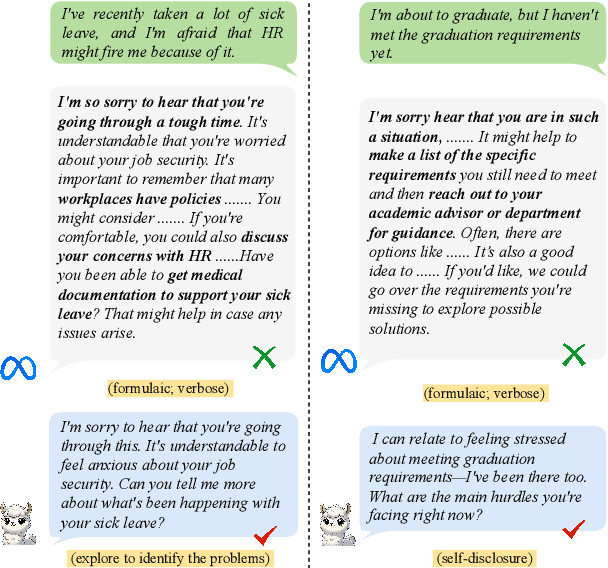
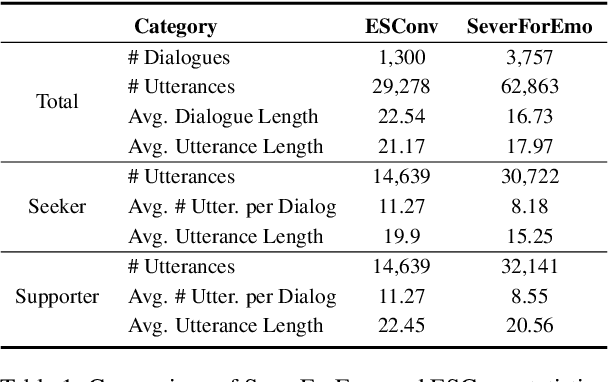
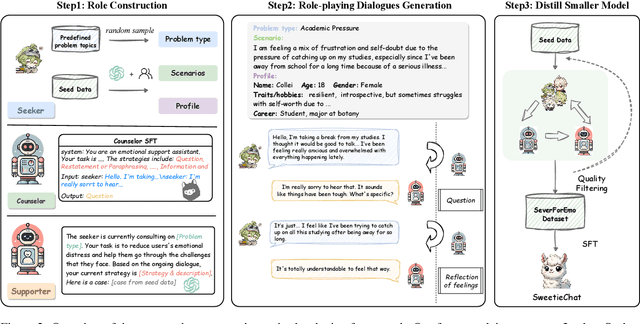
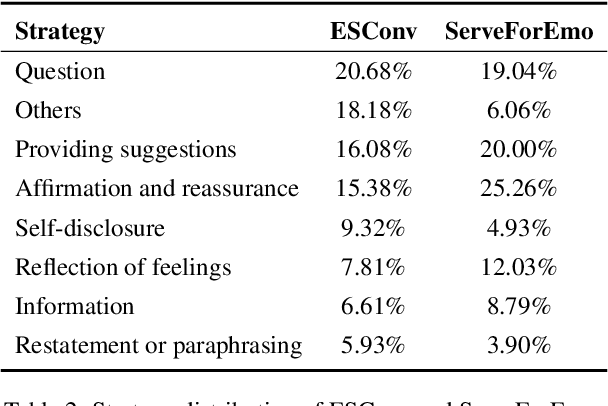
Abstract:Large Language Models (LLMs) have demonstrated promising potential in providing empathetic support during interactions. However, their responses often become verbose or overly formulaic, failing to adequately address the diverse emotional support needs of real-world scenarios. To tackle this challenge, we propose an innovative strategy-enhanced role-playing framework, designed to simulate authentic emotional support conversations. Specifically, our approach unfolds in two steps: (1) Strategy-Enhanced Role-Playing Interactions, which involve three pivotal roles -- Seeker, Strategy Counselor, and Supporter -- engaging in diverse scenarios to emulate real-world interactions and promote a broader range of dialogues; and (2) Emotional Support Agent Training, achieved through fine-tuning LLMs using our specially constructed dataset. Within this framework, we develop the \textbf{ServeForEmo} dataset, comprising an extensive collection of 3.7K+ multi-turn dialogues and 62.8K+ utterances. We further present \textbf{SweetieChat}, an emotional support agent capable of handling diverse open-domain scenarios. Extensive experiments and human evaluations confirm the framework's effectiveness in enhancing emotional support, highlighting its unique ability to provide more nuanced and tailored assistance.
AMPLIFY:Attention-based Mixup for Performance Improvement and Label Smoothing in Transformer
Sep 22, 2023Abstract:Mixup is an effective data augmentation method that generates new augmented samples by aggregating linear combinations of different original samples. However, if there are noises or aberrant features in the original samples, Mixup may propagate them to the augmented samples, leading to over-sensitivity of the model to these outliers . To solve this problem, this paper proposes a new Mixup method called AMPLIFY. This method uses the Attention mechanism of Transformer itself to reduce the influence of noises and aberrant values in the original samples on the prediction results, without increasing additional trainable parameters, and the computational cost is very low, thereby avoiding the problem of high resource consumption in common Mixup methods such as Sentence Mixup . The experimental results show that, under a smaller computational resource cost, AMPLIFY outperforms other Mixup methods in text classification tasks on 7 benchmark datasets, providing new ideas and new ways to further improve the performance of pre-trained models based on the Attention mechanism, such as BERT, ALBERT, RoBERTa, and GPT. Our code can be obtained at https://github.com/kiwi-lilo/AMPLIFY.
Learning from Negative User Feedback and Measuring Responsiveness for Sequential Recommenders
Aug 23, 2023


Abstract:Sequential recommenders have been widely used in industry due to their strength in modeling user preferences. While these models excel at learning a user's positive interests, less attention has been paid to learning from negative user feedback. Negative user feedback is an important lever of user control, and comes with an expectation that recommenders should respond quickly and reduce similar recommendations to the user. However, negative feedback signals are often ignored in the training objective of sequential retrieval models, which primarily aim at predicting positive user interactions. In this work, we incorporate explicit and implicit negative user feedback into the training objective of sequential recommenders in the retrieval stage using a "not-to-recommend" loss function that optimizes for the log-likelihood of not recommending items with negative feedback. We demonstrate the effectiveness of this approach using live experiments on a large-scale industrial recommender system. Furthermore, we address a challenge in measuring recommender responsiveness to negative feedback by developing a counterfactual simulation framework to compare recommender responses between different user actions, showing improved responsiveness from the modeling change.
E2TIMT: Efficient and Effective Modal Adapter for Text Image Machine Translation
May 10, 2023Abstract:Text image machine translation (TIMT) aims to translate texts embedded in images from one source language to another target language. Existing methods, both two-stage cascade and one-stage end-to-end architectures, suffer from different issues. The cascade models can benefit from the large-scale optical character recognition (OCR) and MT datasets but the two-stage architecture is redundant. The end-to-end models are efficient but suffer from training data deficiency. To this end, in our paper, we propose an end-to-end TIMT model fully making use of the knowledge from existing OCR and MT datasets to pursue both an effective and efficient framework. More specifically, we build a novel modal adapter effectively bridging the OCR encoder and MT decoder. End-to-end TIMT loss and cross-modal contrastive loss are utilized jointly to align the feature distribution of the OCR and MT tasks. Extensive experiments show that the proposed method outperforms the existing two-stage cascade models and one-stage end-to-end models with a lighter and faster architecture. Furthermore, the ablation studies verify the generalization of our method, where the proposed modal adapter is effective to bridge various OCR and MT models.
Multi-Teacher Knowledge Distillation For Text Image Machine Translation
May 10, 2023Abstract:Text image machine translation (TIMT) has been widely used in various real-world applications, which translates source language texts in images into another target language sentence. Existing methods on TIMT are mainly divided into two categories: the recognition-then-translation pipeline model and the end-to-end model. However, how to transfer knowledge from the pipeline model into the end-to-end model remains an unsolved problem. In this paper, we propose a novel Multi-Teacher Knowledge Distillation (MTKD) method to effectively distillate knowledge into the end-to-end TIMT model from the pipeline model. Specifically, three teachers are utilized to improve the performance of the end-to-end TIMT model. The image encoder in the end-to-end TIMT model is optimized with the knowledge distillation guidance from the recognition teacher encoder, while the sequential encoder and decoder are improved by transferring knowledge from the translation sequential and decoder teacher models. Furthermore, both token and sentence-level knowledge distillations are incorporated to better boost the translation performance. Extensive experimental results show that our proposed MTKD effectively improves the text image translation performance and outperforms existing end-to-end and pipeline models with fewer parameters and less decoding time, illustrating that MTKD can take advantage of both pipeline and end-to-end models.
Improving End-to-End Text Image Translation From the Auxiliary Text Translation Task
Oct 08, 2022



Abstract:End-to-end text image translation (TIT), which aims at translating the source language embedded in images to the target language, has attracted intensive attention in recent research. However, data sparsity limits the performance of end-to-end text image translation. Multi-task learning is a non-trivial way to alleviate this problem via exploring knowledge from complementary related tasks. In this paper, we propose a novel text translation enhanced text image translation, which trains the end-to-end model with text translation as an auxiliary task. By sharing model parameters and multi-task training, our model is able to take full advantage of easily-available large-scale text parallel corpus. Extensive experimental results show our proposed method outperforms existing end-to-end methods, and the joint multi-task learning with both text translation and recognition tasks achieves better results, proving translation and recognition auxiliary tasks are complementary.
Sequential Convolutional Recurrent Neural Networks for Fast Automatic Modulation Classification
Sep 09, 2019



Abstract:A novel and efficient end-to-end learning model for automatic modulation classification (AMC) is proposed for wireless spectrum monitoring applications, which automatically learns from the time domain in-phase and quadrature (IQ) data without requiring the design of hand-crafted expert features. With the intuition of convolutional layers with pooling serving as front-end feature distillation and dimensionality reduction, sequential convolutional recurrent neural networks (SCRNNs) are developed to take complementary advantage of parallel computing capability of convolutional neural networks (CNNs) and temporal sensitivity of recurrent neural networks (RNNs). Experimental results demonstrate that the proposed architecture delivers overall superior performance in signal to noise ratio (SNR) range above -10 dB, and achieves significantly improved classification accuracy from 80% to 92.1% at high SNRs, while drastically reduces the training and prediction time by approximately 74% and 67%, respectively. Furthermore, a comparative study is performed to investigate the impacts of various SCRNN structure settings on classification performance. A representative SCRNN architecture with the two-layer CNN and subsequent two-layer long short-term memory (LSTM) is developed to suggest the option for fast AMC.
Infer Implicit Contexts in Real-time Online-to-Offline Recommendation
Jul 08, 2019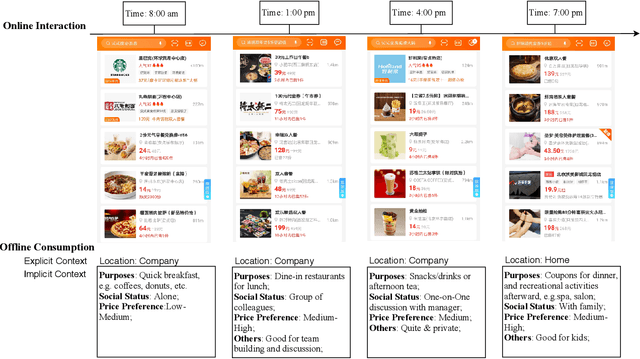

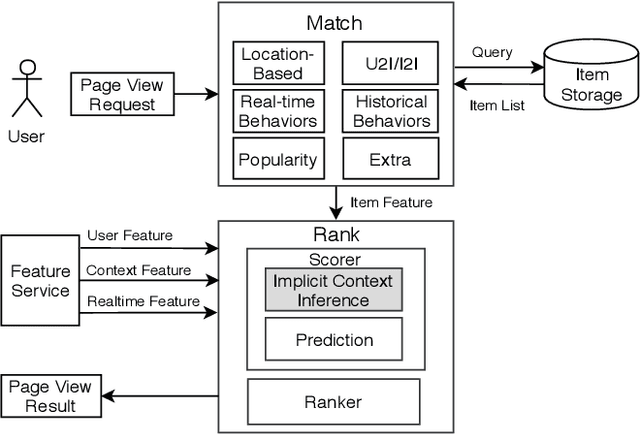
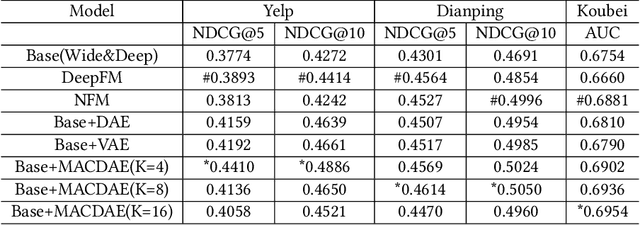
Abstract:Understanding users' context is essential for successful recommendations, especially for Online-to-Offline (O2O) recommendation, such as Yelp, Groupon, and Koubei. Different from traditional recommendation where individual preference is mostly static, O2O recommendation should be dynamic to capture variation of users' purposes across time and location. However, precisely inferring users' real-time contexts information, especially those implicit ones, is extremely difficult, and it is a central challenge for O2O recommendation. In this paper, we propose a new approach, called Mixture Attentional Constrained Denoise AutoEncoder (MACDAE), to infer implicit contexts and consequently, to improve the quality of real-time O2O recommendation. In MACDAE, we first leverage the interaction among users, items, and explicit contexts to infer users' implicit contexts, then combine the learned implicit-context representation into an end-to-end model to make the recommendation. MACDAE works quite well in the real system. We conducted both offline and online evaluations of the proposed approach. Experiments on several real-world datasets (Yelp, Dianping, and Koubei) show our approach could achieve significant improvements over state-of-the-arts. Furthermore, online A/B test suggests a 2.9% increase for click-through rate and 5.6% improvement for conversion rate in real-world traffic. Our model has been deployed in the product of "Guess You Like" recommendation in Koubei.
 Add to Chrome
Add to Chrome Add to Firefox
Add to Firefox Add to Edge
Add to Edge